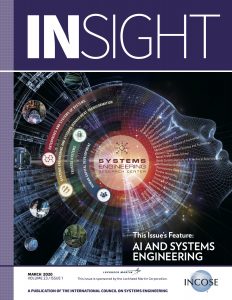The March 2020 issue of INSIGHT addresses augmented and artificial intelligence (AI) for systems engineering (AI4SE) and systems engineering for augmented and artificial intelligence (SE4AI). SE4AI addresses the transformation we need in methods, procedures, and tools (MPTs) to engineer systems with embedded AI to be fit for purpose and doing no (unintended) harm. AI4SE addresses challenges that have to be overcome to leverage AI in the practice of systems engineering much as a lever or pulley provides mechanical advantage to perform work in Newtonian mechanics.
Tenets of systems engineering from control systems engineering are that engineered systems be observable, controllable (to assure system stability with tolerable errors), and identifiable (Möller 2016). AI is in the forefront of technology advances with widely publicized innovations in image identification, diagnostics, and autonomy; AI applications gone awry are newsworthy in both the popular and scientific/engineering media.
AI methods can be broadly classed as rule-based and neural-network based. Rule-based methods are relatively mature with decades of experience in application and are well-understood. In contrast, much is unknown of the contextually driven behavioral characteristics of neural network-based AI, commonly referred to as machine learning and deep learning.
Neural network performance is critically dependent on the datasets used to train the algorithms and whose actions currently cannot be guaranteed to be fit for purpose to meet the attributes of elegance that systems accomplish their intended purposes, be resilient to effects in real-world operation, while minimizing unintended actions, side effects, and consequences (Griffin 2010).
The articles below represent the Systems Engineering Research Center’s (SERC) ongoing research in addressing AI4SE and SE4AI challenges as stated in their research roadmap for AI and autonomy (SERC 2019).
NOTE: All articles are available via open access courtesy of INCOSE and Wiley for the entire duration of 2020.
AI4SE and SE4AI: A Research Roadmap
Tom McDermott, Dan DeLaurentis, Peter Beling, Mark Blackburn, and Mary Bone
Knowledge Representation with Ontologies and Semantic Web Technologies to Promote Augmented and Artificial Intelligence in Systems Engineering
Thomas Hagedorn, Mary Bone, Benjamin Kruse, Ian Grosse, Mark Blackburn
As Smart as a Human? Leveraging Models of Human Intelligence to Assess the Intelligence of Systems
Barclay R. Brown
Test and Evaluation for Artificial Intelligence
Laura Freeman
Exploiting Augmented Intelligence in Systems Engineering and Engineered Systems
Azad M. Madni
Motivating a Systems Theory of AI
Tyler Cody, Stephen Adams, and Peter Beling
A Systems Engineering Approach for Artificial Intelligence: Inspired by the VLSI Revolution of Mead & Conway
Jon Wade, Jorge Buenfil, and Paul Collopy
Validation Testing of Autonomous Learning Systems
Paul Collopy, Valerie Sitterle and Jennifer Petrillo
AI as Systems Engineering Augmented Intelligence for Systems Engineers
William B. Rouse
REFERENCES
- Griffin, M. D. 2010. “How do we fix system engineering?” 61st International Astronautical Congress. Prague, CZ; 27 September – 1 October.
- Möller, D. P. F. 2016. Guide to Computing Fundamentals in Cyber-Physical Systems: Concepts, Design Methods, and Applications. Springer, CH.
- Systems Engineering Research Center. 2020. “Research Roadmaps 2019-2020.”

